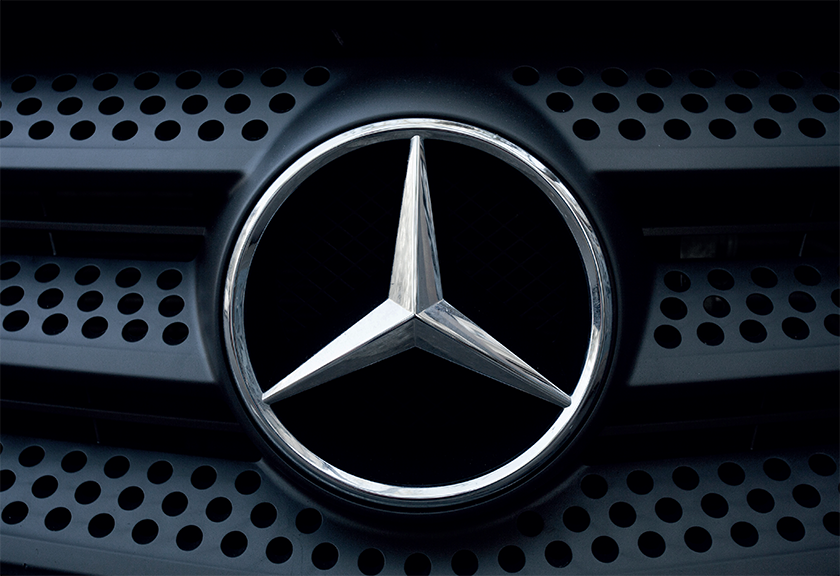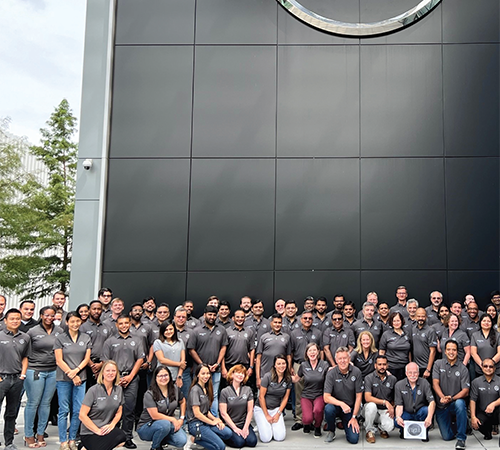
Going electric with Mercedes-Benz: the latest from a car-making colossus
Founded in 1926, the Mercedes-Benz brand traces its roots all the way back to 1885, when Karl Benz first constructed the Benz Patent-Motorwagen. Widely regarded as the first practical automobile, the self-propelled vehicle resembled a motor tricycle, fixed with a rear-mounted engine. Close to a century later, the Mercedes-Benz Group AG (MBAG) is one of the globe’s leading suppliers of premium and luxury cars, and an independent manufacturer of commercial vehicles. Headquartered in Stuttgart, Germany, within the state of Baden-Württemberg, the group achieved revenues of 169 billion euros in 2021.
It was thanks to the work of Max Hoffman, an Austrian-born, New York-based importer of luxury European automobiles, that importation of Mercedes-Benz vehicles to the US began in 1952. Hoffman recognized a growing demand for existing and new models in the post-war American market, one on which he sought to capitalize. Among the cars brought across the Atlantic was the iconic Mercedes 300SL Gullwing, introduced at the 1954 International Motor Sports Show in New York City. More than 80 percent of the 300SL’s total production of approximately 1400 units were sold in the US, making it the first Mercedes-Benz widely successful outside its home market. So significant was the Gullwing’s impact, the model is now credited with changing the image of Mercedes- Benz in the US from a manufacturer of solid but staid luxury automobiles, to one capable of producing high-performance sports cars.
 Unique position
Unique position
Buoyed by the success of the Gullwing, by 1957, Mercedes-Benz was in a position to expand its reach across the US. The company entered into an initial distribution agreement with Studebaker-Packard Corporation, before striking out on its own eight years later, with the formation of Mercedes-Benz USA (MBUSA). Now a wholly owned subsidiary of MBAG, MBUSA is a nationwide organization, responsible for the distribution, marketing, and customer service for all Mercedes- Benz passenger and commercial van products in the US.
“We occupy a unique position within MBAG,” explains Rory Anne Hepner, Director of Global Vehicle Logistics and Customs at MBUSA. “For all the plants, there’s a central MBAG sales team that moves all the cars built in Europe to markets throughout the world. MBUSA is not only a market that receives those cars, but we also act on behalf of MBAG, moving cars out of the USA.”
Both a customer and a vendor of MBAG, MBUSA employs approximately 1,600 people across the United States. The company also has 383 associated dealership partners and offers a diverse line-up of models, from the sporty A-Class sedan to the flagship S-Class and the all-electric EQS. In the US, one type of vehicle stands apart: the SUV, or Sports Utility Vehicle. As the name suggests, SUVs’ combination of utility, luxury, and reliability makes them a popular choice for families, while appealing to a particularly American appetite for adventure. It follows, then, that Mercedes-Benz large SUVs are manufactured exclusively in the US, at the Mercedes-Benz US International (MBUSI) plant in Tuscaloosa County, Alabama. Working with MUBSI, MBUSA will collect the finished vehicles for distribution, including the GLE, GLS,GLE Coupe and Maybach GLS. There is more to come, too. The company started production of the EQS SUV in August 2022 and is set to roll out its electric EQE SUV later this year, with MBUSA already gearing up to distribute the vehicles across the US and beyond.
“If you talk to any company that’s involved with the moving of finished electric vehicles, there’s a whole new abundance of learning curves to process,” Rory indicates. “For instance, there are limits to the allowed level of charge for vehicles that travel across the ocean, on trains, or via trucks. The heaviness of the vehicles also impacts our load factor, which in turn challenges our ability to safely load vehicles while still supporting our carriers with fair rates for moving such vehicles.”
“As sustainability becomes an ever more important factor across the sector, and particularly for MBAG, we need to do our best to help the Mercedes EQ family,” she goes on. “We launched the first EQS last year. Now, with other EQ models to follow, we are witnessing the beginning of what is the biggest innovation currently being undertaken across the brand. At the same time, we need to continue to provide our customers with the most luxurious experience possible, and to define what that experience looks like in the context of an electric vehicle.”
Operational efficiencies
As it pivots towards electric vehicles, MBUSA is also investing heavily in the installation of charging infrastructure at its key facilities, including at its Vehicle Preparation Center (VPC), located in Brunswick, Georgia. The site is one of five VPC facilities in the US that serve as the first stop, after US Customs, for new Mercedes-Benz vehicles destined for Mercedes-Benz dealerships throughout the country, while also serving as the company’s largest port for exports.
“We’re also heavily investing in providing our people with the necessary training to move electric vehicles safely,” Rory continues. “Electric vehicles pose different challenges to internal combustion cars; for the company, it’s like starting again after 130 years, and for our employees, that means being careful, and being confident in what you’re doing. As the Tuscaloosa plant rolls out a greater number of electric vehicles, we need to take things one step at a time to ensure that we’re able to fulfill our responsibility safely and efficiently.”
These investments sit within broader efforts at MBUSA to streamline its port operations. “It’s our responsibility to get Mercedes- Benz cars to the ports, and then out of the country to their destination markets,” Rory reiterates. “When finished vehicles wait at a port, they aren’t getting any prettier – we need to keep them moving. With that in mind, we have recently launched a focus on operational efficiencies. We’ve improved how long we hold the cars at port, both through engaging directly with the shipping lines, and through the launch of a dedicated team to handle our finished vehicles exports.”
Since taking these steps, MBUSA is already reaping the rewards. Rory reveals that operations at both the Tuscaloosa facility and the Brunswick port have become more cost and time efficient – an impressive feat, given the ongoing delays influencing shipping routes around the globe. “We’ve been tracking our progress since taking over these responsibilities in August of 2020,” she notes. “Our inventories at the Brunswick port have fallen by around 50 percent, simply because we’re singularly focused on moving vehicles at the port as quickly as possible.
“With ownership and control, it also allows us to be more disciplined,” Rory adds. “From a quality standpoint, we’ve worked closely with MBUSI to develop our own inspection procedures, which take place at the last gate before the vehicles leave the US. For MBAG, meanwhile, they no longer have to concern themselves with the movement of vehicles, because that responsibility falls to us, and it represents our number one priority. Overall, it’s been a very positive development both for MBUSA, and for the MBAG enterprise worldwide.”
All of MBUSA’s efforts over the last two years have taken place against the backdrop of uncertainty, as the initial arrival of the Covid-19 pandemic gave way to months of supply chain volatility, with shortages, increased lead times, and delays posing fresh challenges to companies across the manufacturing and distribution sectors. The shortage of semiconductor chips has proved a particular obstacle for the automotive sector, combined with an exodus of workers from the rail and trucking industries that constitute the vehicle supply chain.
“Every single mode of transportation has been impacted by the pandemic,” Rory reflects. “Moving finished vehicles is complicated enough, but we’ve nevertheless had to do our best to diversify. If at one point transportation via rail was proving to be challenge, we had to shift our emphasis to trucks. That in turn will then throw up its difficulties, and we will have to shift once again.
“We’re fortunate to have launched a brand-new SAP-based system, VOIS, in 2019, which has given us the agility to be able to alternate how we move our vehicles with relative speed,” she continues. “We’re able to put in new rail routes fairly easily, add truck routes on a daily basis, and the system gives us the transparency to know at exactly which point in our supply chain vehicles are located, and to keep them moving accordingly.”
Managing relationships
VOIS isn’t the only software that MBUSA has onboarded. The company has also adopted Cognosos, a cloud-based inventory management software, providing instantaneous access to real-time location information across the company’s yard at the MBUSI Alabama facility. “As chip or part shortages have become more frequent, we’ve encountered situations where we’ve had cars waiting in the yard that weren’t ready to distribute to market,” Rory explains. “Cognosos gives us the ability to conduct tracking far more efficiently, combining data from our yard with data from MBUSI. As vehicles are moved throughout the site, their locations are updated automatically on the system. We’re therefore able to keep much better track of the vehicles, and find them more efficiently.”
Moving into the latter half of 2022, the automotive industry continues to grapple with a number of supply chain disruptions. For MBUSA, it’s a period that’s underlined the importance of a robust network of suppliers – or “partners”, as Rory is keen to emphasize. “Throughout the supply chain, we’re all under stress: from production, through to your carriers, and 3PL, as we try to navigate current challenges,” she confirms. “We’re all working with limited resources, and some days you won’t be their number one priority. However, it’s important to recognize that no one is purposely trying to make your job difficult.
“Instead, it’s about how you manage that relationship with respect, trust, and transparency,” she continues. “If your partners inform you that they have an issue, and let you know when they’ll have it fixed, there’s no
benefit to be had from beating them up if they fail to meet that deadline. Rather, you’ve got to work together to find new solutions. It’s the same when we’re working to get cars to our dealers: yes, we want everyone to be our priority, but we have to be realistic. If you offer your partners that transparency, they’ll give it back to you.”
Not to be forgotten, underpinning MBUSA’s hard work are the company’s employees. “In the Finished Vehicle Logistics team, we’re a group of 33 corporate office employees, and just over 140 individuals total, moving close to 500,000 vehicles in the USA; all with the goal to make a difference and get stuff done,” Rory insists. “They’re the hardest-working people I’ve seen in logistics. When you’re moving cars, you’ve consistently got to bring your A-game to the table and execute every day. If not, there will be consequences in the months to follow.
“Our team embraces this challenge,” Rory continues. “At the same time, we’re supportive of each other, and we make sure to keep things fun. Every day, I remind my team of the need to put our work in perspective. What we do is important, but ultimately, we are just moving luxury products around the world – we are not conducting brain or heart surgery. Developing that culture has been a key component of the work we have done over the last couple of years, and it goes hand in hand with our efforts to improve and streamline our operations.
“We love what we do at MBUSA, and take great pride in the vehicles that we produce and distribute throughout the US and the world,” Rory concludes. “Through an ever-changing environment, we continue to work hard every day to meet the demands of our customers.”
www.mbusa.com/en/home